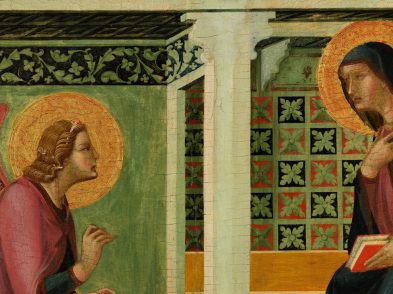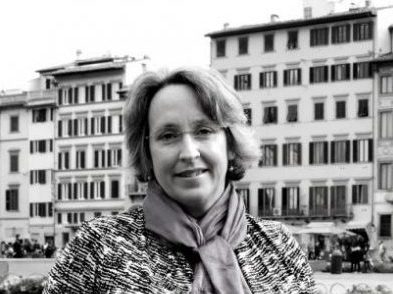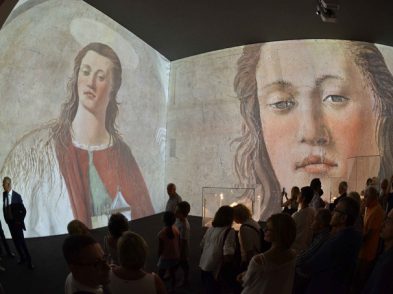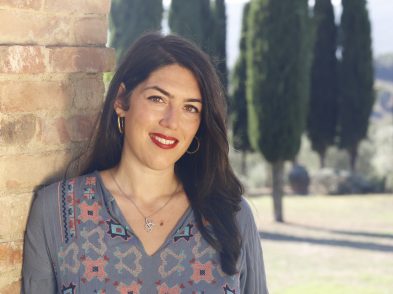Sometimes
you meet someone whose vitality and dedication to a cause is so far beyond the
norm that you are left speechless. Daniela Murphy Corella has such a
‘wow-factor.’ Brilliant, energetic and eloquent, she is the kind of person who
can make change happen. And change is what she wants.
A professional conservator of wall paintings and oil
paintings on canvas and wood, Daniela is one of the founders and president of
the Associazione Bastioni (via S. Niccolò 93R; www.ass-bastioni.com). This association is the first of
its kind in Italy: it brings together top-level professional restorers from
different specializations under one roof. When I visited, one conservator was
working on a marble sculpture alongside someone working on a religious triptych
not far from where a third person was examining an oil portrait painting, and I
almost bumped into a frame conservator when she stepped back to examine her
work. In this environment, the restorers share information on techniques,
materials and best practices; they face and solve problems together; they
assist each other with the endless bureaucracy involved in working with
artistic heritage; and they try to increase awareness and promote the role of
the restorer in contemporary society.
The space
may sound cramped and cluttered, but it isn’t. While not a large area by any
means, the studio is completely different from other restoration workshops one
finds around Santo Spirito and San Frediano. Whereas many of those workshops
have a certain dusty, medieval charm, they also tend to induce claustrophobia.
In contrast, Bastioni conveys the cutting-edge, state-of-the-art
professionalism that informs the work at hand: in addition to the shared office
space, storage and efficient lighting, it is well ventilated; the restorers use
environmentally friendly gels and non-toxic substances; it is secure, with
thick bullet-proof glass and special windows; and insured, by both the
association and the clients, depending on the work underway. And it’s located
in a fun and easy-to-reach part of the city.
Bastioni
differs from many other Florentine studios not just physically, but also
philosophically. Unlike the denizens of the old-style restorer’s workshop, una bottega del restauratore, where secrets are jealously
protected, Murphy and her team share information. This philosophy is
exemplified in the book that she edited with Alberto Felici, TIPS: Finding Your Way Around Sites and Workshops. They pooled their resources and
asked their professional friends around the world for one tip that had proved
essential over the years. The result is a useful guide for young and
experienced restorers alike. However, Murphy notes, few suggestions came from
‘local elders.’
Murphy has
two big goals. One is to establish a guild of restorers in Italy. A guild would
vet credentials and determine professional status in a transparent manner,
helping to raise standards, protect the profession, encourage cooperation and
open the workforce. Her other goal is to have Bastioni officially recognized by
the European Confederation Conservator-Restorers’ Organization (ECCO). Official
EU recognition of Bastioni would help give the profession of restoration in
Italy a status commensurate with its artistic heritage. By way of comparison:
Italy has 20,000 professional conservators and three EU-recognized associations
for these professionals, while the United Kingdom, with 8,000 conservators, has
four recognized professional associations of conservators.
The process
of gaining international recognition is long and arduous. It means adopting a
more modern approach to restoration, often called passive conservation, that
may seem counterintuitive in the face of deteriorated artworks, kind of like
holding a popsicle in front of an air conditioner in the hopes it doesn’t melt.
However, new technologies can measure the amount, kind and intensity of
intervention necessary, and these technologies are under constant improvement
and refinement. Murphy maintains close contact with independent observers from
the United Kingdom to discuss the pros and cons of the passive conservative
approach.
Mainly,
Murphy wants restorers to be respected for the depth and potential of their
contribution to Italy’s cultural heritage. ‘A restorer shouldn’t be looked at
as just an operaio; he or she should have the respect
and support to be able to stand up at a worksite and say, “No, signor ingegnere, this is not the way it is. The
work needs to be approached in such a manner…”‘
Born in
Madrid to a Spanish mother and Irish father, Murphy has lived around the world,
eventually choosing Florence out of her love for its art. Her vision of
collaboration and healthy competition is ‘foreign’: describing a series of
debates on conservation hosted by the Bastioni, she laughingly observed,
‘Italians don’t understand how debates work!’
One of the
ways she would like to see the profession of art restoration grow is through
highly visible conservation projects and school initiatives. Her outreach
efforts have created a small library for public consultation at the High Bar, a
neighborhood bar where Bastioni also holds aperitivo discussions and meetings (and enjoys regular-client
status). Bastioni also distributes a newsletter with articles on such topics as
how to become a recognized restorer, interviews with experts like Vittorio
Sgarbi and Alfio Del Serra, and reviews of local art shows.
When she’s
not planning conferences, writing articles, teaching at SACI Studio Arts
Centers International (www.saci-florence.org), working with other conservators,
writing a novel (her first book, The Restorer, was published in 2011 by Guerilla), Murphy can be
found on the scaffolding at Santa Croce, communicating with Agnolo Gaddi, the
Maestro di Figline, who painted the wooden crucifixion in the 14th century,
currently being restored in a project sponsored by the non-profit American
association Friends of Florence (www.friendsofflorence.org).
See more
about the Bastioni Asociation at www.ass-bastioni.com. Visits to the
conservation projects at Santa Croce are by appointment: call 055/2466105 (dial
3) between 11am and 3pm or email booking@santacroceopera.it,
specifying the date and time of the requested visit, the language (visits in
English are held only on specific days), the number of people, a cell phone
number to contact, and the names and dates of birth of the participants.
Falling in love with Florence and looking for a place to stay long-term? Or are you an expat searching for a place to house all those extra guests who can’t get enough of the Renaissance city? There are many long-term and short-term holiday apartment rentals in Florence waiting for you!








